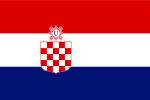Navy of the Independent State of Croatia
| Navy of the Independent State of Croatia Ratna Mornarica Nezavisne Države Hrvatske | |
|---|---|
 A 250t-class torpedo boat similar to T7, which was operated by the RMNDH in the Adriatic Sea between September 1943 and June 1944 when she was sunk | |
| Active | 1941–1944 |
| Disbanded | May 1945 |
| Country | |
| Type | Navy |
| Size | 1,262 personnel (1943) |
| Part of | Croatian Armed Forces |
| Headquarters | Zagreb, Independent State of Croatia |
| Engagements | World War II |
| Commanders | |
| Notable commanders | Đuro Jakčin Edgar Angeli Nikola Steinfl |
| Insignia | |
| Naval Ensign (1941–1944) |  |
| Naval Ensign (1944–1945) |  |
The Navy of the Independent State of Croatia (
The RMNDH was only a small part of the armed forces of the NDH, largely due to restrictions imposed by
Background
On 10 April 1941, four days after the
The
Formation
The Navy of the Independent State of Croatia (Croatian: Ratna Mornarica Nezavisne Države Hrvatske, RMNDH) was established by the Law on the Establishment of the Army and Navy issued on the same day as the NDH was established by the Ustaše deputy leader and retired Austro-Hungarian
The Coast and Maritime Traffic Command comprised three naval commands for the northern, central and southern sections of the Adriatic coast, headquartered at Crikvenica (later Sušak), Makarska (later Split) and Dubrovnik respectively. These commands were further divided into naval districts; North Adriatic Naval Command was divided into the Kraljevica and Senj Naval Districts, Central Adriatic Naval Command comprised the Omiš, Supertar, Makarska, Metković and Hvar Naval Districts, and South Adriatic Naval Command consisted of the Trpanj, Orebić and Dubrovnik Naval Districts. The naval districts consisted mainly of naval and weather stations, and were only responsible for coast guard and customs duties.[11][12]
The River and River Traffic Command was headquartered in
Re-organisation

The Law Decree on the Armed Forces of 18 March 1942 re-organised the RMNDH as a branch of the
Zniam was stranded on 19 December 1943 and was torpedoed by
During the war, a unit known as the
Three officers commanded the RMNDH:[12]
- Kontraadmiral (Rear admiral) Đuro Jakčin (1941 – late 1943)
- Kapetan bojnog broda (Commodore) Edgar Angeli (late 1943 – 1944)
- Kontraadmiral Nikola Steinfel (1944 – May 1945)
See also
- Military ranks of the Independent State of Croatia
- Croatian Navy
- Croatian Armed Forces
- Croatian Air Force
- Croatian Air Force Legion
Footnotes
- ^ Tomasevich 2001, pp. 52–53, 272.
- ^ Tomasevich 2001, pp. 233–234.
- ^ Tomasevich 2001, p. 31.
- ^ Shores, Cull & Malizia 1987, pp. 205–207, 213–218, 220–224.
- ^ a b Whitely 2001, p. 312.
- ^ Chesneau 1980, pp. 357–358.
- ^ Freivogel & Rastelli 2015, p. 97.
- ^ Tomasevich 2001, p. 417.
- ^ Chesneau 1980, p. 356.
- ^ Tomasevich 2001, p. 237 (with map on p. 236).
- ^ a b c Niehorster 2013.
- ^ a b c d e f Thomas & Mikulan 1995, p. 18.
- ^ Tomasevich 2001, pp. 423–424.
- ^ Gardiner 1985, p. 339.
- ^ Chesneau 1980, p. 357.
- ^ Chesneau 1980, p. 359.
- ^ Paterson 2015, p. 223.
- ^ Chesneau 1980, p. 358.
- ^ Tomasevich 2001, p. 431.
- ^ a b Müller 2012, p. 98.
- ^ Brnardic 2016, p. 12.
- ^ a b Müller 2012, p. 100.
References
- Brnardic, Vladimir (2016). World War II Croatian Legionaries: Croatian Troops under Axis Command 1941–45. London: Bloomsbury Publishing. ISBN 978-1-4728-1768-6.
- Chesneau, Roger, ed. (1980). Conway's All the World's Fighting Ships 1922–1946. London, UK: Conway Maritime Press. ISBN 978-0-85177-146-5.
- Freivogel, Zvonimir & Rastelli, Achille (2015). Adriatic Naval War 1940-1945. Zagreb, Croatia: Despot Infinitus. ISBN 978-953-7892-44-9.
- Gardiner, Robert, ed. (1985). Conway's All the World's Fighting Ships 1906–1921. London, UK: Conway Maritime Press. ISBN 978-0-85177-245-5.
- ISBN 978-1-78076-890-8.
- Naval Records Club (1965). "The Independent Croatian Navy". Warship International. 2. Rutland, Massachusetts: International Naval Research Organization. ISSN 0043-0374.)
{{cite journal}}: CS1 maint: ref duplicates default (link - Naval Records Club (1968). "Yugoslavian Monitors". Warship International. 5. Toledo, Ohio: International Naval Research Organization: 333. OCLC 1647131.
- Niehorster, Leo (2013). "Armed Forces of the Independent State of Croatia – Order of Battle Croatian Navy 1st July 1941". Leo Niehorster. Retrieved 11 March 2015.
- Paterson, Lawrence (2015). Schnellboote: A Complete Operational History. Barnsley, UK: Seaforth Publishing. ISBN 978-1-84832-083-3.
- Shores, Christopher F.; Cull, Brian; Malizia, Nicola (1987). Air War for Yugoslavia, Greece, and Crete, 1940–41. London, England: Grub Street. ISBN 978-0-948817-07-6.
- ISBN 978-0-8047-3615-2.
- Thomas, Nigel; Mikulan, Krunoslav (1995). Axis Forces in Yugoslavia 1941–45. New York, New York: Osprey Publishing. ISBN 978-1-85532-473-2.
- Whitely, M. J. (2001). Destroyers of World War Two: An International Encyclopedia. Annapolis, Maryland: U.S. Naval Institute Press. ISBN 978-0-87021-326-7.
